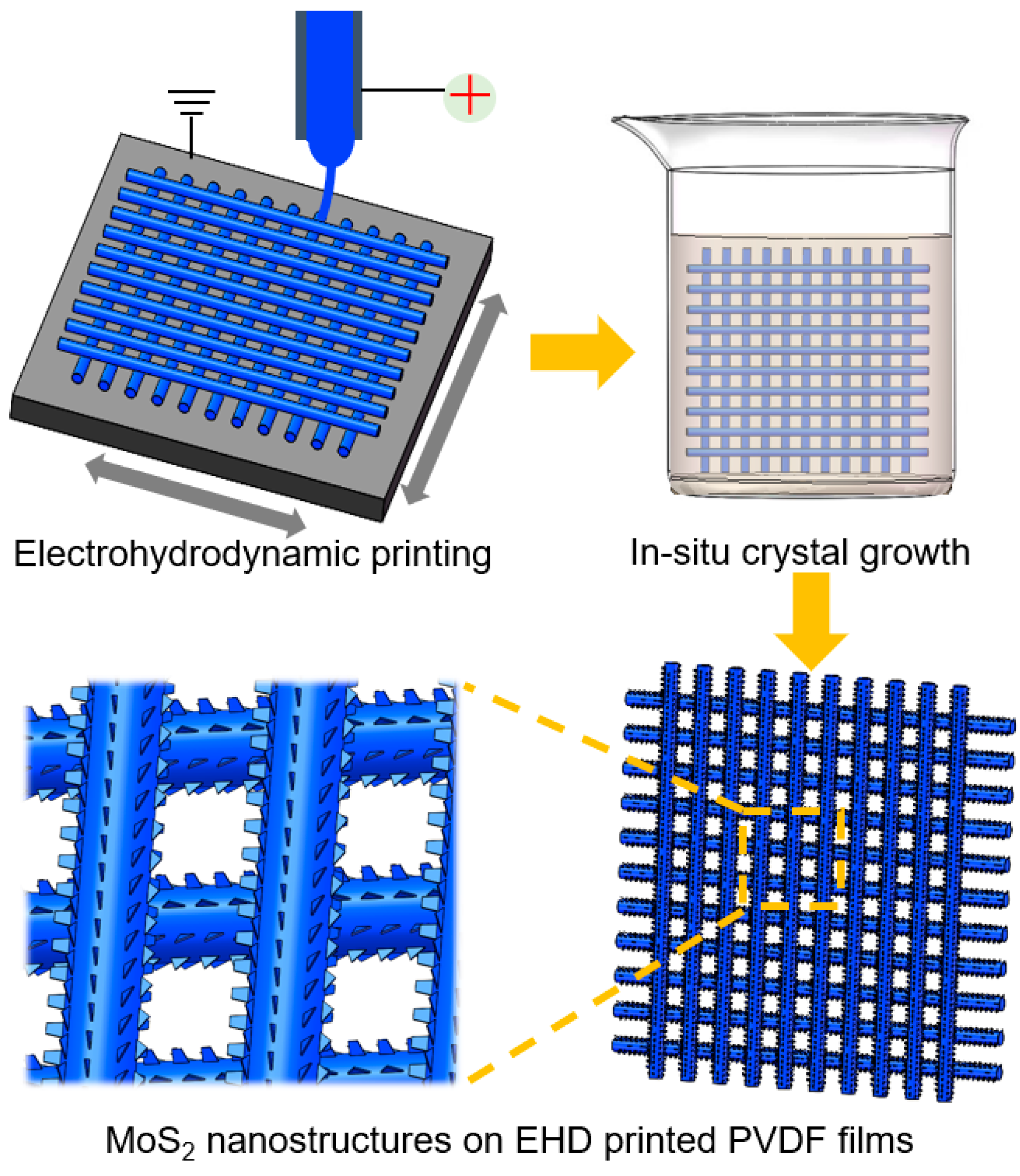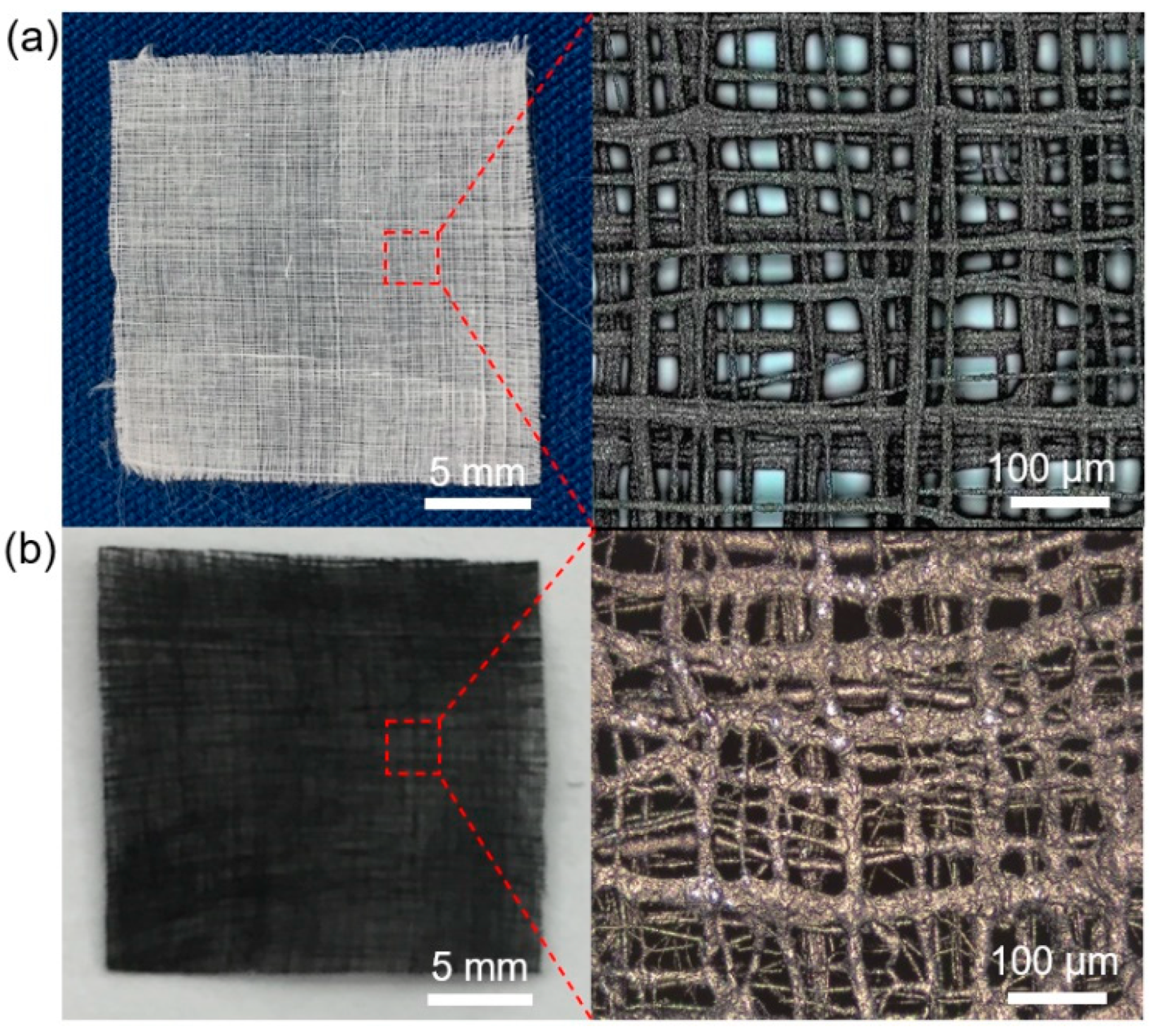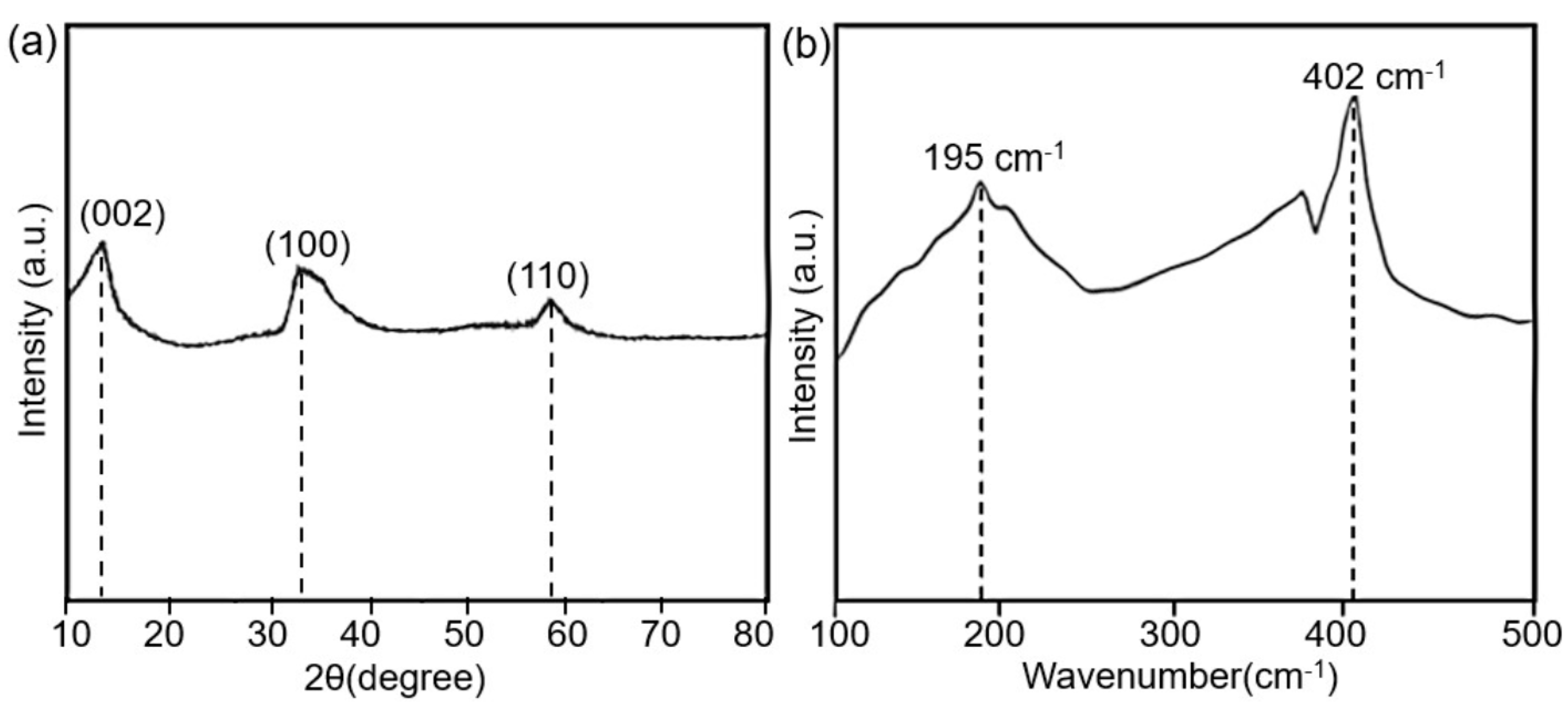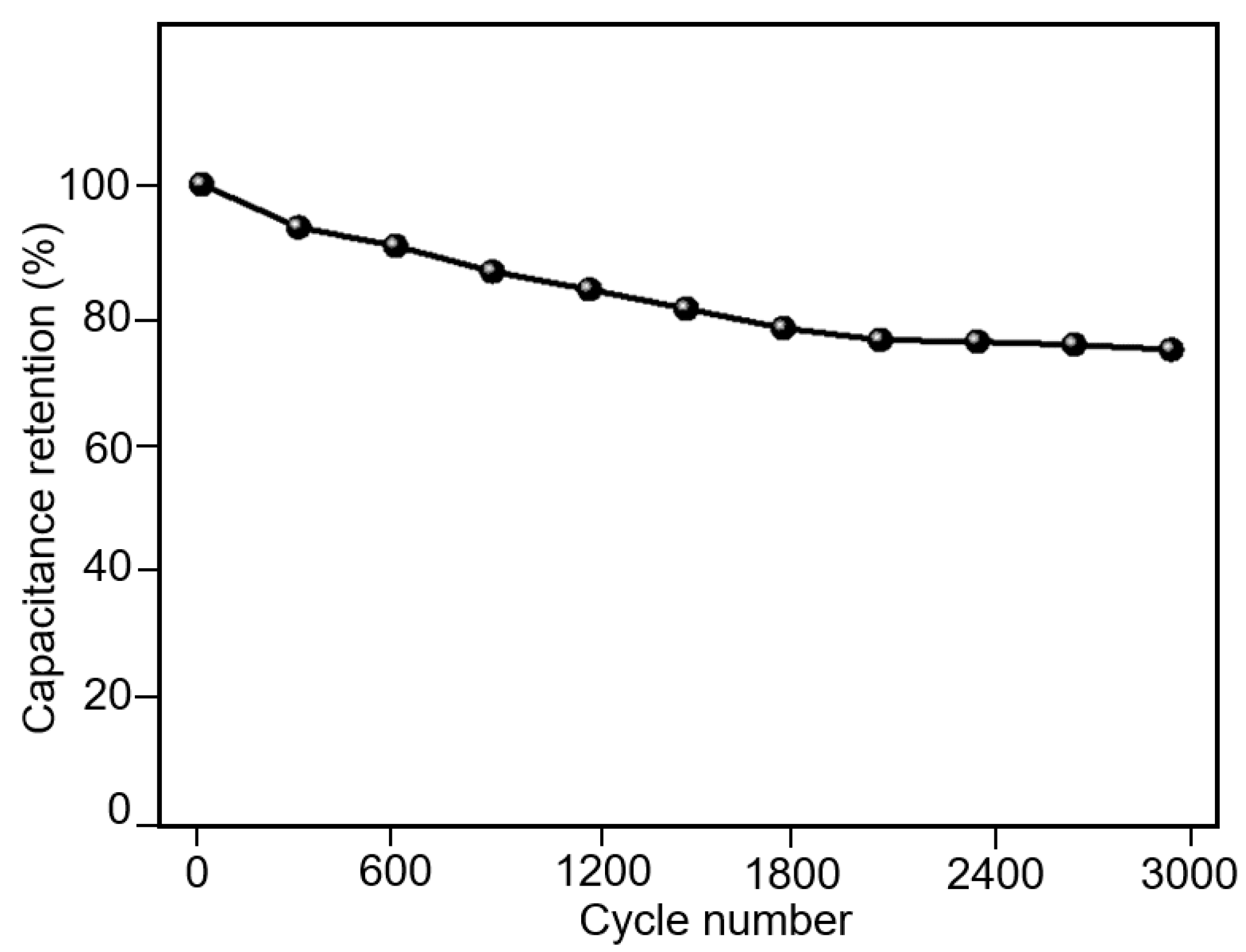In-Situ Assembly of MoS2 Nanostructures on EHD-Printed Microscale PVDF Fibrous Films for Potential Energy Storage Applications
Abstract
:1. Introduction
2. Materials and Methods
2.1. Materials for EHD Printing
2.2. EHD Printing of the PVDF Film
2.3. The Assembly of MoS2 Nanostructures on EHD-Printed Film
2.4. Structural Observation and Material Characterization
2.5. Electrochemical Measurements
3. Results
3.1. EHD Printing of the Microscale PVDF Fibers
3.2. In-Situ Assembly of MoS2 Nanostructure on EHD-Printed PVDF Fibrous Films
3.3. Potential Energy Storage Capacity of the MoS2-PVDF Composite Film as Supercapacitor Electrode
4. Discussion
5. Conclusions
Author Contributions
Funding
Conflicts of Interest
References
- Adam, A.A.; Ojur Dennis, J.; Al-Hadeethi, Y.; Mkawi, E.; Abubakar Abdulkadir, B.; Usman, F.; Mudassir Hassan, Y.; Wadi, I.; Sani, M. State of the art and new directions on electrospun lignin/cellulose nanofibers for supercapacitor application: A systematic literature review. Polymers 2020, 12, 2884. [Google Scholar] [CrossRef] [PubMed]
- Zhang, L.; Li, X.; Yang, M.; Chen, W. High-safety separators for lithium-ion batteries and sodium-ion batteries: Advances and perspective. Energy Storage Mater. 2021, 41, 522–545. [Google Scholar] [CrossRef]
- Ruano, G.; Iribarren, J.I.; Pérez-Madrigal, M.M.; Torras, J.; Alemán, C. Electrical and capacitive response of hydrogel solid-like electrolytes for supercapacitors. Polymers 2021, 13, 1337. [Google Scholar] [CrossRef] [PubMed]
- Xu, H.; Shen, M. The control of lithium-ion batteries and supercapacitors in hybrid energy storage systems for electric vehicles: A review. Int. J. Energy Res. 2021, 45, 20524–20544. [Google Scholar] [CrossRef]
- Kim, C.; Zhu, C.; Aoki, Y.; Habazaki, H. Heteroatom-doped porous carbon with tunable pore structure and high specific surface area for high performance supercapacitors. Electrochim. Acta 2019, 314, 173–187. [Google Scholar] [CrossRef]
- Cao, J.; Zhu, C.; Aoki, Y.; Habazaki, H. Starch-derived hierarchical porous carbon with controlled porosity for high performance supercapacitors. ACS Sustain. Chem. Eng. 2018, 6, 7292–7303. [Google Scholar] [CrossRef]
- Liu, X.; Lai, C.; Xiao, Z.; Zou, S.; Liu, K.; Yin, Y.; Liang, T.; Wu, Z. Superb electrolyte penetration/absorption of three-dimensional porous carbon nanosheets for multifunctional supercapacitor. ACS Appl. Energy Mater. 2019, 2, 3185–3193. [Google Scholar] [CrossRef]
- Xiang, L.; Luo, D.; Yang, J.; Sun, X.; Qi, Y.; Qin, S. Preparation and comparison of properties of three phase change energy storage materials with hollow fiber membrane as the supporting carrier. Polymers 2019, 11, 1343. [Google Scholar] [CrossRef] [Green Version]
- Fleischmann, S.; Mitchell, J.B.; Wang, R.; Zhan, C.; Jiang, D.-e.; Presser, V.; Augustyn, V. Pseudocapacitance: From fundamental understanding to high power energy storage materials. Chem. Rev. 2020, 120, 6738–6782. [Google Scholar] [CrossRef]
- He, P.; He, J.; Huo, Z.; Li, D. Microfluidics-based fabrication of flexible ionic hydrogel batteries inspired by electric eels. Energy Storage Mater. 2022, 49, 348–359. [Google Scholar] [CrossRef]
- Egorov, V.; Gulzar, U.; Zhang, Y.; Breen, S.; O’Dwyer, C. Evolution of 3d printing methods and materials for electrochemical energy storage. Adv. Mater. 2020, 32, 2000556. [Google Scholar] [CrossRef] [PubMed]
- Zhang, M.; Mei, H.; Chang, P.; Cheng, L. 3d printing of structured electrodes for rechargeable batteries. J. Mater. Chem. A 2020, 8, 10670–10694. [Google Scholar] [CrossRef]
- Mai, Z.; Liu, D.; Chen, Z.; Lin, D.; Zheng, W.; Dong, X.; Gao, Q.; Zhou, W. Fabrication and application of photocatalytic composites and water treatment facility based on 3d printing technology. Polymers 2021, 13, 2196. [Google Scholar] [CrossRef] [PubMed]
- Zhou, G.; Li, M.C.; Liu, C.; Wu, Q.; Mei, C. 3d printed ti3c2tx mxene/cellulose nanofiber architectures for solid-state supercapacitors: Ink rheology, 3d printability, and electrochemical performance. Adv. Funct. Mater. 2022, 32, 2109593. [Google Scholar] [CrossRef]
- Nguyen, J.; Stwodah, R.M.; Vasey, C.L.; Rabatin, B.E.; Atherton, B.; D’Angelo, P.A.; Swana, K.W.; Tang, C. Thermochromic fibers via electrospinning. Polymers 2020, 12, 842. [Google Scholar] [CrossRef] [Green Version]
- Zhang, B.; He, J.; Lei, Q.; Li, D. Electrohydrodynamic printing of sub-microscale fibrous architectures with improved cell adhesion capacity. Virtual Phys. Prototyp. 2020, 15, 62–74. [Google Scholar] [CrossRef]
- Zhang, B.; He, J.; Zheng, G.; Huang, Y.; Wang, C.; He, P.; Sui, F.; Meng, L.; Lin, L. Electrohydrodynamic 3d printing of orderly carbon/nickel composite network as supercapacitor electrodes. J. Mater. Sci. Technol. 2021, 82, 135–143. [Google Scholar] [CrossRef]
- Liashenko, I.; Rosell-Llompart, J.; Cabot, A. Ultrafast 3d printing with submicrometer features using electrostatic jet deflection. Nat. Commun. 2020, 11, 753. [Google Scholar] [CrossRef] [Green Version]
- Liang, Y.; Zhao, J.; Huang, Q.; Hu, P.; Xiao, C. Pvdf fiber membrane with ordered porous structure via 3d printing near field electrospinning. J. Membr. Sci. 2021, 618, 118709. [Google Scholar] [CrossRef]
- Lee, T.H.; Chen, C.Y.; Tsai, C.Y.; Fuh, Y.K. Near-field electrospun piezoelectric fibers as sound-sensing elements. Polymers 2018, 10, 692. [Google Scholar] [CrossRef]
- Luo, G.; Teh, K.S.; Liu, Y.; Zang, X.; Wen, Z.; Lin, L. Direct-write, self-aligned electrospinning on paper for controllable fabrication of three-dimensional structures. ACS Appl. Mater. Interfaces 2015, 7, 27765–27770. [Google Scholar] [CrossRef] [PubMed] [Green Version]
- Vijayavenkataraman, S.; Zhang, S.; Thaharah, S.; Sriram, G.; Lu, W.F.; Fuh, J.Y.H. Electrohydrodynamic jet 3d printed nerve guide conduits (ngcs) for peripheral nerve injury repair. Polymers 2018, 10, 753. [Google Scholar] [CrossRef] [PubMed] [Green Version]
- Zhang, B.; He, J.; Li, X.; Xu, F.; Li, D. Micro/nanoscale electrohydrodynamic printing: From 2d to 3d. Nanoscale 2016, 8, 15376–15388. [Google Scholar] [CrossRef]
- He, J.; Hao, G.; Meng, Z.; Cao, Y.; Li, D. Expanding melt-based electrohydrodynamic printing of highly-ordered microfibrous architectures to cm-height via in situ charge neutralization. Adv. Mater. Technol. 2021, 7, 2101197. [Google Scholar] [CrossRef]
- Zhang, C.-L.; Jiang, Z.-H.; Lu, B.-R.; Liu, J.-T.; Cao, F.-H.; Li, H.; Yu, Z.-L.; Yu, S.-H. Mos2 nanoplates assembled on electrospun polyacrylonitrile-metal organic framework-derived carbon fibers for lithium storage. Nano Energy 2019, 61, 104–110. [Google Scholar] [CrossRef]
- Sarkar, D.; Das, D.; Das, S.; Kumar, A.; Patil, S.; Nanda, K.K.; Sarma, D.; Shukla, A. Expanding interlayer spacing in MoS2 for realizing an advanced supercapacitor. ACS Energy Lett. 2019, 4, 1602–1609. [Google Scholar] [CrossRef] [Green Version]
- Dong, Y.; Zhang, S.; Du, X.; Hong, S.; Zhao, S.; Chen, Y.; Chen, X.; Song, H. Boosting the electrical double-layer capacitance of graphene by self-doped defects through ball-milling. Adv. Funct. Mater. 2019, 29, 1901127. [Google Scholar] [CrossRef]
- Lee, J.-S.M.; Briggs, M.E.; Hu, C.-C.; Cooper, A.I. Controlling electric double-layer capacitance and pseudocapacitance in heteroatom-doped carbons derived from hypercrosslinked microporous polymers. Nano Energy 2018, 46, 277–289. [Google Scholar] [CrossRef]
- Zhang, W.; Liu, H.; Zhang, X.; Li, X.; Zhang, G.; Cao, P. 3d printed micro-electrochemical energy storage devices: From design to integration. Adv. Funct. Mater. 2021, 31, 2104909. [Google Scholar] [CrossRef]
- Tümer, E.H.; Erbil, H.Y. Extrusion-based 3d printing applications of pla composites: A review. Coatings 2021, 11, 390. [Google Scholar] [CrossRef]
- Awasthi, P.; Banerjee, S.S. Fused deposition modeling of thermoplastic elastomeric materials: Challenges and opportunities. Addit. Manuf. 2021, 46, 102177. [Google Scholar] [CrossRef]
- Zhang, B.; He, J.; Li, J.; Wang, L.; Li, D. Microscale electrohydrodynamic printing of in situ reactive features for patterned zno nanorods. Nanotechnology 2019, 30, 475301. [Google Scholar] [CrossRef] [PubMed]
- Li, L.; Liu, W.; Dong, H.; Gui, Q.; Hu, Z.; Li, Y.; Liu, J. Surface and interface engineering of nanoarrays toward advanced electrodes and electrochemical energy storage devices. Adv. Mater. 2021, 33, 2004959. [Google Scholar] [CrossRef] [PubMed]
- Guo, X.; Bae, J.; Ding, Y.; Zhang, X.; Yu, G. Liquid alloy enabled solid-state batteries for conformal electrode–electrolyte interfaces. Adv. Funct. Mater. 2021, 31, 2010863. [Google Scholar] [CrossRef]
- Thong, P.T.; Sadhasivam, T.; Kim, N.-I.; Kim, Y.A.; Roh, S.-H.; Jung, H.-Y. Highly conductive current collector for enhancing conductivity and power supply of flexible thin-film zn–mno2 battery. Energy 2021, 221, 119856. [Google Scholar] [CrossRef]
- Woo, S.; Nam, D.; Chang, W.; Ko, Y.; Lee, S.; Song, Y.; Yeom, B.; Moon, J.H.; Lee, S.W.; Cho, J. A layer-by-layer assembly route to electroplated fibril-based 3d porous current collectors for energy storage devices. Small 2021, 17, 2007579. [Google Scholar] [CrossRef]
- Lei, Z.; Liu, L.; Zhao, H.; Liang, F.; Chang, S.; Li, L.; Zhang, Y.; Lin, Z.; Kröger, J.; Lei, Y. Nanoelectrode design from microminiaturized honeycomb monolith with ultrathin and stiff nanoscaffold for high-energy micro-supercapacitors. Nat. Commun. 2020, 11, 299. [Google Scholar] [CrossRef] [Green Version]
- Eun, J.H.; Sung, S.M.; Kim, M.S.; Choi, B.K.; Lee, J.S. Effect of mwcnt content on the mechanical and piezoelectric properties of pvdf nanofibers. Mater. Des. 2021, 206, 109785. [Google Scholar] [CrossRef]
- Qian, Y.; Kang, D.J. Poly (dimethylsiloxane)/zno nanoflakes/three-dimensional graphene heterostructures for high-performance flexible energy harvesters with simultaneous piezoelectric and triboelectric generation. ACS Appl. Mater. Interfaces 2018, 10, 32281–32288. [Google Scholar] [CrossRef]







Publisher’s Note: MDPI stays neutral with regard to jurisdictional claims in published maps and institutional affiliations. |
© 2022 by the authors. Licensee MDPI, Basel, Switzerland. This article is an open access article distributed under the terms and conditions of the Creative Commons Attribution (CC BY) license (https://creativecommons.org/licenses/by/4.0/).
Share and Cite
Zhang, B.; Li, S.; Qureshi, M.S.H.; Mia, U.; Ge, Z.; Song, A. In-Situ Assembly of MoS2 Nanostructures on EHD-Printed Microscale PVDF Fibrous Films for Potential Energy Storage Applications. Polymers 2022, 14, 5250. https://doi.org/10.3390/polym14235250
Zhang B, Li S, Qureshi MSH, Mia U, Ge Z, Song A. In-Situ Assembly of MoS2 Nanostructures on EHD-Printed Microscale PVDF Fibrous Films for Potential Energy Storage Applications. Polymers. 2022; 14(23):5250. https://doi.org/10.3390/polym14235250
Chicago/Turabian StyleZhang, Bing, Shikang Li, M. Shafin. H. Qureshi, Ukil Mia, Zhenghui Ge, and Aiping Song. 2022. "In-Situ Assembly of MoS2 Nanostructures on EHD-Printed Microscale PVDF Fibrous Films for Potential Energy Storage Applications" Polymers 14, no. 23: 5250. https://doi.org/10.3390/polym14235250




